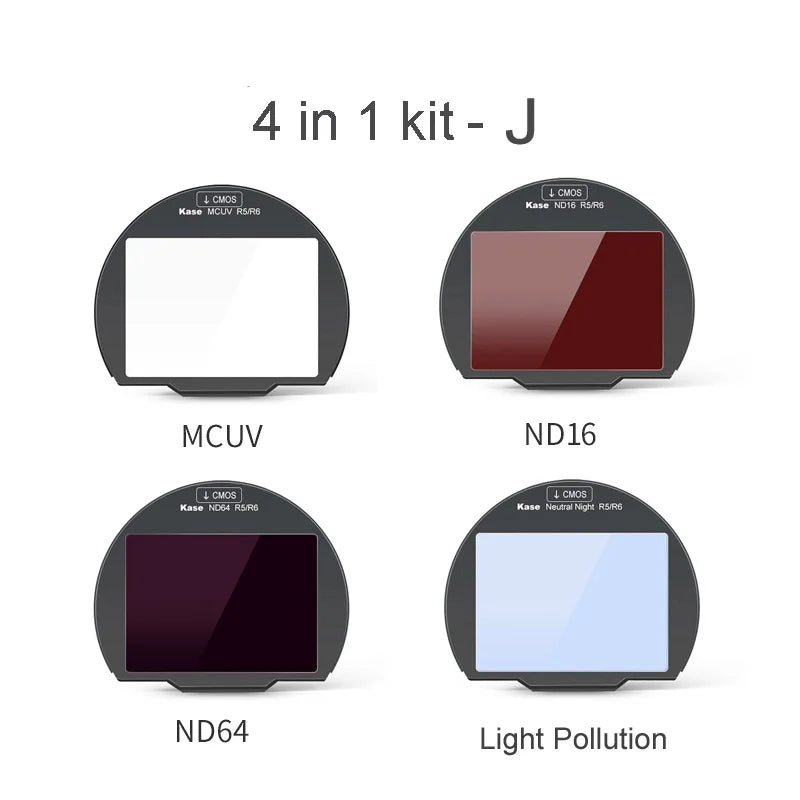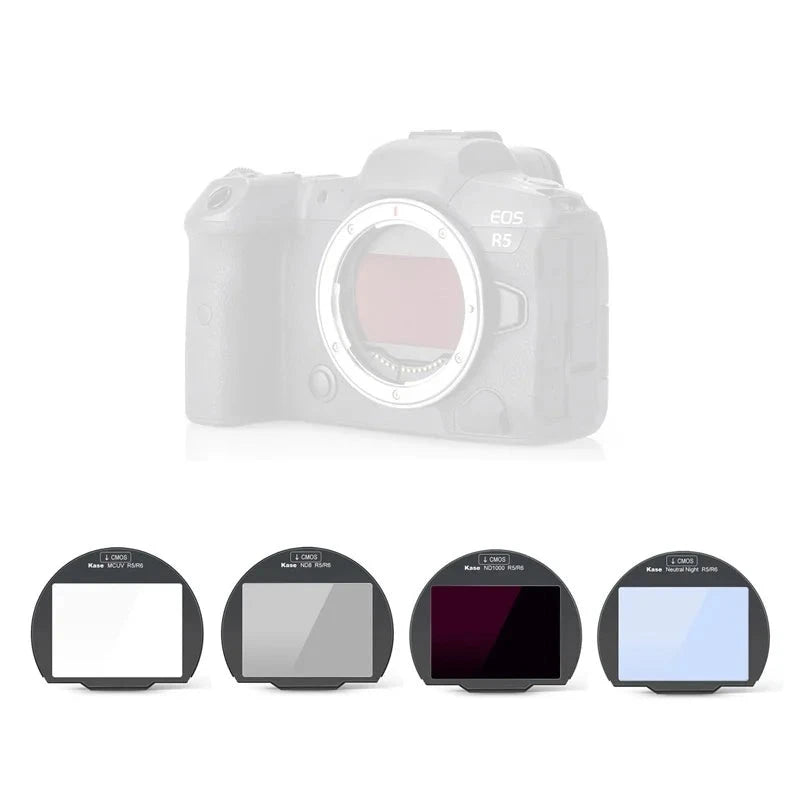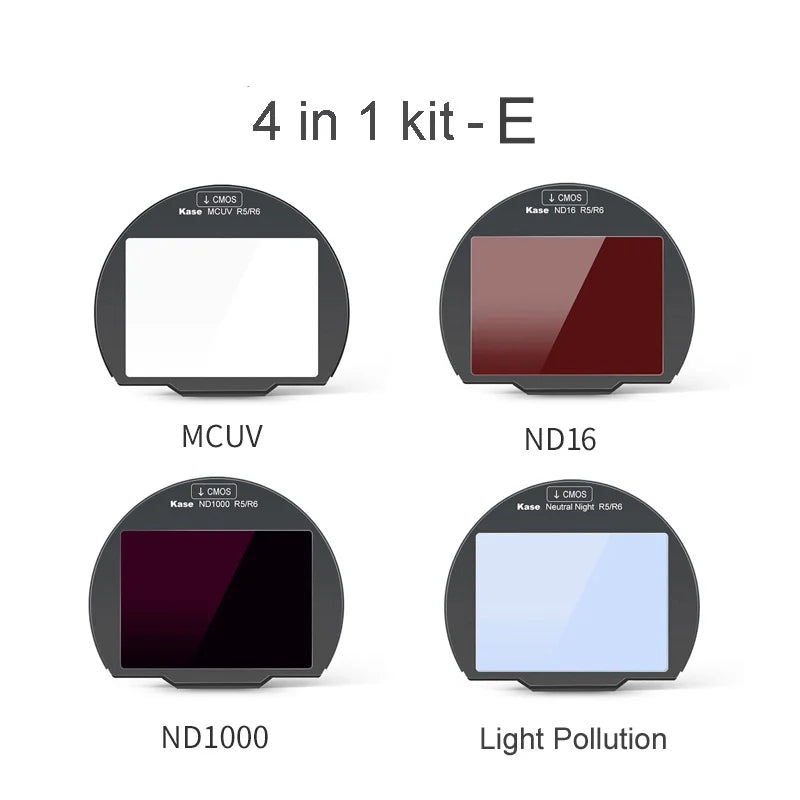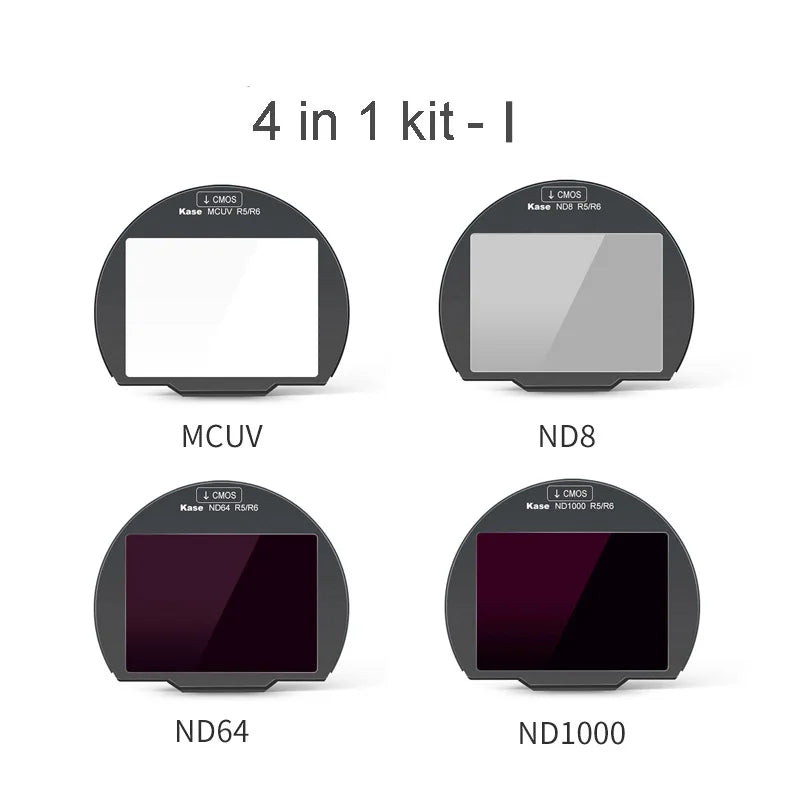Kase
Kase Clip-in Filter 4 in 1 Kit For Canon R3 / R5 / R6 Camera
Kase Clip-in Filter 4 in 1 Kit For Canon R3 / R5 / R6 Camera
FREE SHIPPING
Couldn't load pickup availability
Kase Clip-in Filter 4 in 1 Kit For Canon R3 / R5 / R6 Camera (MCUV / ND8 / ND16 / ND32 / ND64 / ND1000 / Neutral Night)
Equip your Canon R3, R5, or R6 camera with the versatile Kase Clip-in Filter 4 in 1 Kit, featuring essential MCUV, ND8, ND16, ND32, ND64, ND1000, and Neutral Night filters for optimal photographic flexibility.
Seamless Integration
Install these clip-in filters directly in front of the CMOS sensor of your Canon R3, R5, or R6 camera body without affecting the functionality of the lens or adapter mount. Enjoy seamless integration for uninterrupted shooting.
Lightweight and Portable Design
Weighing only 4.1g each, the Kase Clip-in Filters are lightweight and easy to carry, making them perfect for various shooting scenarios. Crafted from durable B270 optical glass and 6063 aluminum alloy, they offer robust protection and reliability.
Key Features
Enhanced Protection and Image Quality
The Kase Clip-in Filters protect the light-reducing element and act as a shield for the CMOS sensor. The B270 optical glass with a waterproof and oil-proof coating ensures high-definition imaging with reduced reflections.
Specifications
- Material: B270 optical glass / 6063 aluminum alloy
- Weight: 4.1g each
- Application: Canon R5, R6
Package Contents
- Clip-in filters x4
- Installation instructions
- Plastic inner box
- Packing box
Why Clip-In Filters are Good?
Clip-in filters offer several advantages that make them a popular choice among photographers, especially those using mirrorless and DSLR cameras with interchangeable lens systems. Here are some reasons why clip-in filters are beneficial:
1. Directly in Front of the Sensor:
Clip-in filters are placed directly in front of the camera's CMOS or CCD sensor. This positioning ensures that the filter affects the light before it reaches the sensor, allowing for precise control over the image's characteristics without interfering with the lens's optical properties.
2. Maintain Lens Flexibility:
Unlike traditional screw-on filters that attach to the front of the lens, clip-in filters do not alter the lens's filter thread or require different filter sizes for different lenses. This maintains the flexibility to use various lenses without needing multiple filters.
3. Prevent Vignetting:
Clip-in filters are designed to fit perfectly within the camera's sensor housing, which helps prevent vignetting—the darkening of corners in the image—commonly caused by traditional filters when used with wide-angle lenses.
4. Ease of Use and Stability:
Once installed, clip-in filters remain securely in place during use, offering stability and reliability. This makes them suitable for long exposures, time-lapse photography, and situations where changing filters quickly and efficiently is crucial.
5. Protecting the Sensor:
Clip-in filters also act as a barrier to protect the camera's sensor from dust, moisture, and scratches, particularly when shooting in challenging environments. They contribute to extending the lifespan and performance of the camera's internal components.
6. Minimal Optical Impact:
High-quality clip-in filters, made from materials like optical glass with multi-coatings, maintain excellent optical quality with minimal impact on image sharpness, color fidelity, and overall image quality. This ensures that the filter enhances rather than detracts from the photograph.
7. Versatility and Adaptability:
Clip-in filter systems often support a range of filter types, such as ND (Neutral Density), UV, CPL (Circular Polarizer), and specialized filters like light pollution or IR (Infrared). This versatility allows photographers to adapt quickly to different shooting conditions and creative needs.
Clip-in filters combine practicality, optical performance, and convenience, making them an excellent choice for photographers who prioritize image quality, versatility, and ease of use in their photography gear. Whether for professional use or hobbyist applications, clip-in filters offer significant benefits over traditional filter systems, enhancing creative possibilities while maintaining the integrity of the photographic process.
What is MCUV?
MCUV stands for "Multi-Coated Ultraviolet" filter. It is a type of filter commonly used in photography to protect the front element of a camera lens. Here's a brief overview of what MCUV filters are and their purpose:
MCUV Filter Overview:
- UV Protection: MCUV filters primarily serve as ultraviolet (UV) filters, shielding the camera lens from ultraviolet rays that can cause haziness and reduce clarity in photographs, especially in high-altitude and coastal environments where UV light is stronger.
- Multi-Coated Optics: MCUV filters are often multi-coated with layers of anti-reflective coatings. These coatings help to reduce reflections and glare, as well as improve light transmission through the lens, thereby enhancing overall image quality.
- Lens Protection: Beyond UV protection, MCUV filters also act as a physical barrier, safeguarding the front element of the lens from dust, moisture, fingerprints, and scratches. This protection can help extend the lifespan of the lens.
- Minimal Impact on Image Quality: A well-manufactured MCUV filter typically has minimal impact on image quality, especially when using high-quality filters with excellent optical properties. They are designed to be transparent and should not introduce noticeable color shifts or distortions to the image.
- Versatility: MCUV filters are versatile and can be left on the lens permanently, providing constant protection without interfering with the lens's autofocus or metering systems.
Why Choose Kase Clip-in Filter 4 in 1 Kit?
Tailored specifically for Canon R3, R5, and R6 cameras, the Kase Clip-in Filter 4 in 1 Kit enhances your photographic capabilities with essential filters designed for various lighting conditions. Upgrade your gear and capture stunning images with confidence and precision.
Invest in the Kase Clip-in Filter 4 in 1 Kit for Canon R3, R5, and R6 today to elevate your photography and ensure you're prepared for any shooting scenario.
Share






































